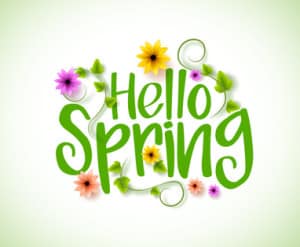 Punxsutawney Phil, that famous ground hog we rely on to tell us spring is on its way, didn’t see his shadow. Spring is around the corner! When the snow is gone and the cold weather gets warmer, it often brings in dust, pollen and other debris into facilities. The winter weather also leaves behind leftover ice remover, such as rock salt, and general dirt and debris. It requires special attention during cleaning in early spring to keep the indoor environment clean.
Punxsutawney Phil, that famous ground hog we rely on to tell us spring is on its way, didn’t see his shadow. Spring is around the corner! When the snow is gone and the cold weather gets warmer, it often brings in dust, pollen and other debris into facilities. The winter weather also leaves behind leftover ice remover, such as rock salt, and general dirt and debris. It requires special attention during cleaning in early spring to keep the indoor environment clean.
Pollen causes what is often referred to as “spring allergies” or “hay fever”. This includes symptoms similar to a cold or flu, such as a runny nose, watery and itchy eyes, coughing and sneezing. Not everyone has allergies, but it does affect over 58 million people in the U.S. each spring, which is about 20% of the U.S. population. The reason some people have allergies is because their body’s immune system treats pollen like bacteria or a virus – this causes the body to release antibodies to fight the potential illness. Although allergies can be annoying, they’re generally mild allowing people to go about their normal daily activities. Some people suffer from much more severe condition, such as asthma, which can be caused by allergies from pollen.
Keep an Eye on the Weather Report
There are a variety of sources to check the weather. Meteorologists can use sophisticated systems to report the potential for high amounts of pollen and other allergens. Sunny, warm days often increase the potential for pollen, while rainy days reduce and help keep pollen at bay. Consider a more aggressive dusting and vacuuming on days when high pollen levels are forecasted, or the next day scheduled to clean.
Wait Until After the First Major Pollination
There’s always several days in the spring that trigger plants and trees to aggressively pollinate, especially after a harsh winter. There’s no exact time or temperature that triggers pollination, but in early spring, the pollen count increases and on some days, can be extremely high. Different types of pollen are released into the air and can travel for miles. Even something as simple as mowing the lawn can cause pollination or spread pollen through the air again. When the pollen count is high, it often stays on your clothes, shoes and even your hair. Open windows can also attract pollen because the particles are small enough to move through window screens. All of this brings pollen into a facility, creating an indoor environment almost as bad as the outdoor environment.
Clean or Replace Your Cleaning Equipment
Spring clean your cleaning supplies before you tackle spring pollen in a facility. Refurbish vacuums and change vacuum cleaner bags. Clean or replace the dust cup and filters in your vacuums. Ensure your vacuums can tackle the pollen brought in that may cling to carpeted areas. You may wish to replace vacuums that don’t seem to be doing the job, even after performing proper maintenance and cleaning to operate more effectively. You can also adjust the vacuum brush to clean carpeted areas more aggressively. Not only will maintaining vacuums help reduce allergens, it’ll increase the life of them.
Along with vacuums, other cleaning equipment such as dusters, mops, rags and brushes should be cleaned or replaced to prepare for spring weather. If you have dusters sponges and rags that are washable, wash, rinse and dry them to start fresh in the spring. Rags can be laundered and dried. Wash polish rags and cleaning rags separately. Use bleach if the rags are white or light-colored. Pollen will adhere to rags, unless aggressive cleaners are used that kill the allergen. Mops can be soaked in bleach and warm water. Dilute the bleach as directed by the manufacturer. Rinse it out and start your mopping in the spring with a clean and sanitized mop – especially in non-carpeted entrance areas. Clean the mop thoroughly after each use to ensure outside allergens are not spread again.
This should be part of your “spring cleaning” checklist, whether it be your home or business.
Replace HVAC Filters
Even if it’s not your responsibility, talk to the person who is responsible for maintaining the HVAC system. Most HVAC, air conditioning, heating and ventilation systems have an air filter that should be properly maintained or replaced every several months. The filter stops most pollen, dust and debris from entering a building by catching the small particles. This makes the indoor environment more comfortable by reducing the allergens and pollutants.
Season changes, such as early spring and mid-fall, can be the best time to refurbish or replace the products and equipment you use for cleaning. Whether you do the cleaning yourself, have internal staff or hire a contract cleaning company to do your cleaning, include it in the list of responsibilities scheduled for specific times of the year. For businesses, a cleaner indoor environment can reduce employee sick time and make the workplace more productive. Simply follow the manufacturer’s instructions for maintaining the equipment to ensure it all works at its best.





